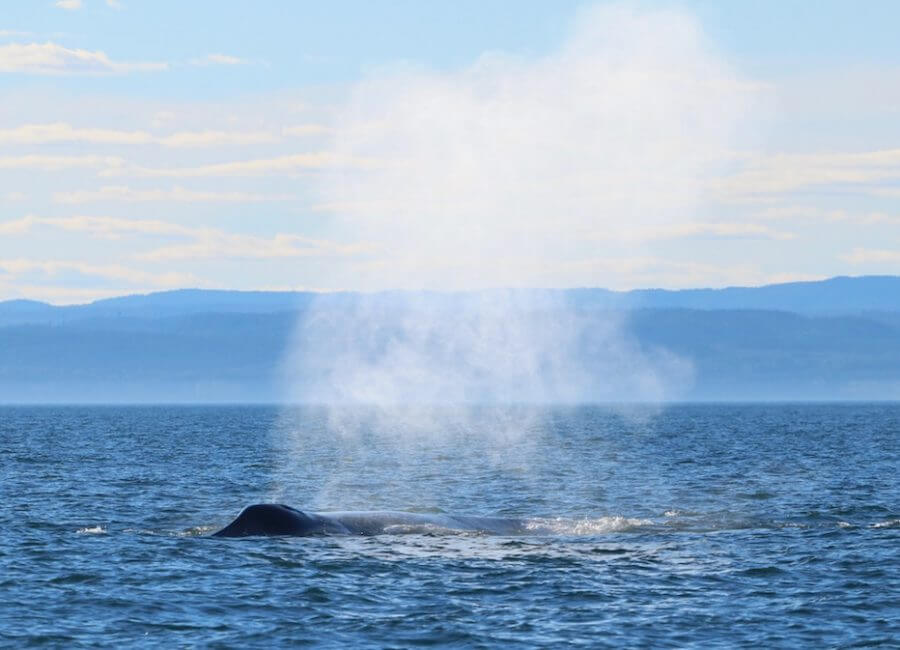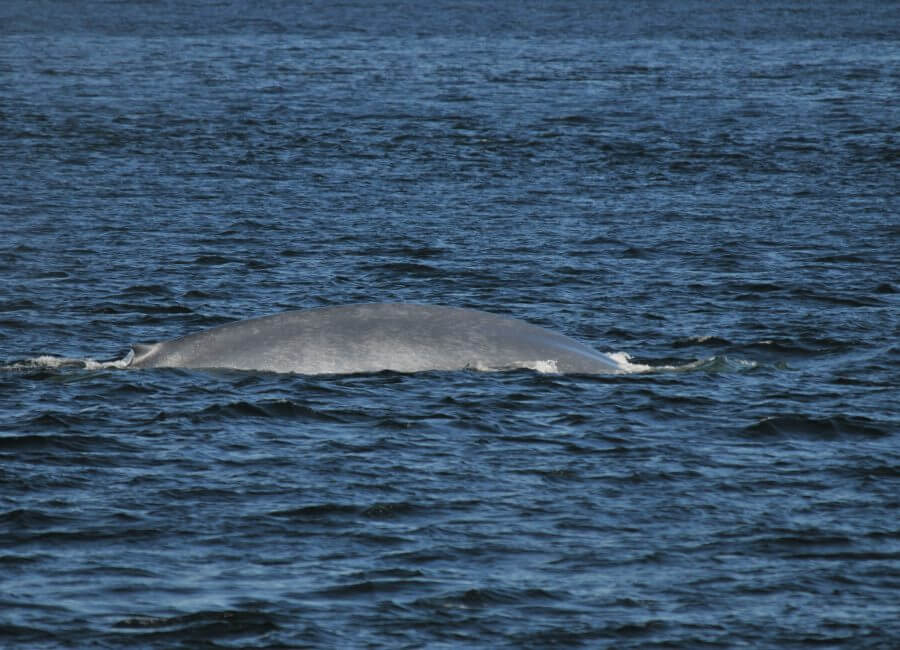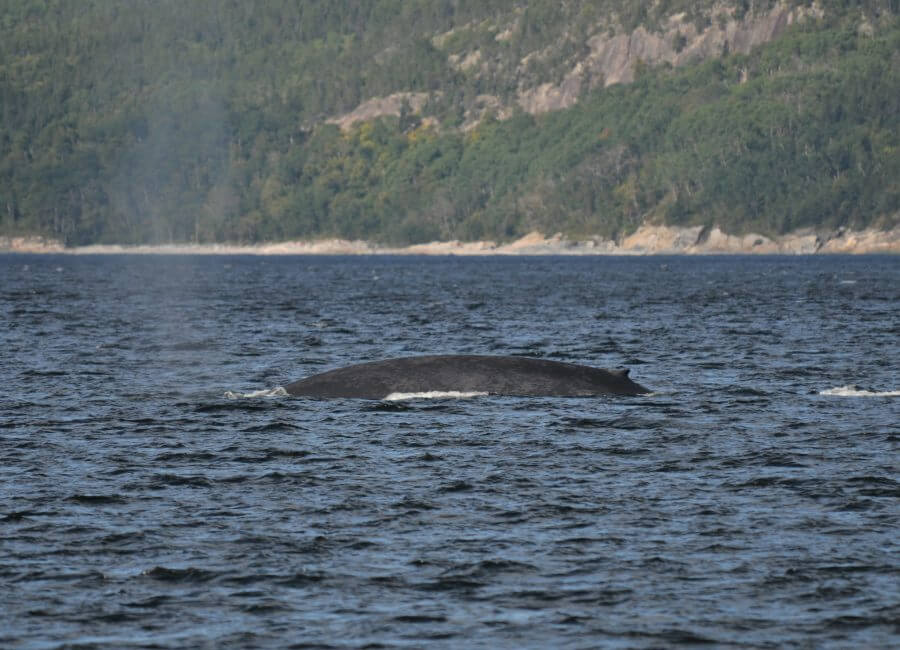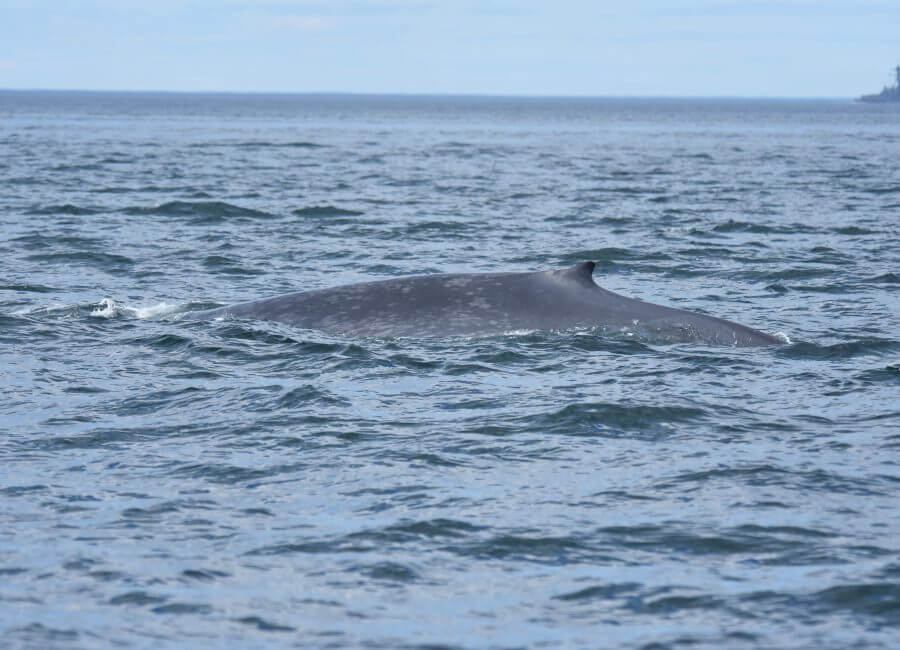Pleiades
Blue Whale


-
ID number
B197
-
Sex
Female
-
Year of birth
Unknown
-
Known Since
1988
Distinctive traits
The only way to recognize B197 is to look closely at the detail of her mottled color pattern.
Life history
In the catalog of St. Lawrence blue whales managed by the Mingan Island Cetacean Study (MICS), B197 is listed as “Pleiades”.
In 2006, teams from GREMM and Fisheries and Oceans Canada’s Maurice Lamontagne Institute carried out telemetric monitoring of the whale as part of the large whale tracking project. A suction cup tag was attached to her back for 24 hours, enabling us to monitor her diving behavior. During the first day, she alternated between deep dives (80 to 100 m) and shallower dives (20 to 40 m), with or without feeding. In the evening, she remained at shallow depths (5 to 30 m). During the night, B197 fed mainly on the surface, and in the early morning, increasingly deeper dives (80 to 100 m) were recorded. Dive data then remained stable until the beacon fell.
In 2008, B197 particularly excited the industry and researchers by returning accompanied by a calf… a rare event, since it was only the 17th blue whale calf observed in the St. Lawrence and documented since 1979!
B197’s visits to the Marine Park have been rather irregular since her first visit to the area in 1988. She seems to prefer the Gaspé Peninsula. She was seen in 2004 at Cap de Grosses-Roches, in 2012 off L’Anse-à-Valleau, and in 2015 on the north side of the Gaspé Peninsula.
Observations history in the Estuary
Years in which the animal was not observed Years in which the animal was observed
Latest news from the publications Portrait de baleines
Although she owes her name to her spotted coat, reminiscent of the constellation of the same name, Pleiades does not have her head in the clouds! This female blue whale has been visiting the estuary irregularly since 1988. She seems to prefer the waters off the Gaspé Peninsula. Towards the end of July, however, she was observed for the second consecutive year in the estuary, projecting her powerful blow from the waves of the St. Lawrence River. As a part of a species in danger of extinction, Pleiades is closely monitored and studied by several research teams, including those from the Mingan Island Cetacean Study (MICS), Fisheries and Oceans Canada (DFO), and the Group for Research and Education on Marine Mammals (GREMM). This is what made it possible to confirm in 2008 that she was a mother! The same observation was made in 2018, off Longue-Rive, thanks to a MICS collaborator. Reaching sexual maturity around 8 to 10 years of age, female blue whales can have a calf every 2 to 3 years on average. While blue whales are estimated to live up to 80 years, could we hope to see Pleaides with another calf by her side? Even if she swam alone this year, let’s keep an eye out for her next visits!
A column-shaped spout over six metres high, a body reaching up to a phenomenal 27 metres and bluish-gray in colour with dark speckling: even at a considerable distance, it’s hard to be mistaken… it’s the imposing blue whale! The long-awaited return of this giant to our waters is confirmed, with two individuals having recently been seen. It was on July 23, in Les Escoumins, that our research assistant photographed them. The identity of one of them is soon confirmed: it is B197, a female who in fact is featured in the catalogue of St. Lawrence blue whales kept by the Mingan Island Cetacean Study (MICS), under the name “Pleiades”. There’s just one way to recognize her, and that is to carefully scrutinize her colour pattern.
In 2006, telemetric monitoring was carried out on her within the framework of the large rorqual monitoring project. The suction-cup tag, which held for 24 hours, provided insight into her diving behaviour. Then, in 2008, B197 really stirred up the industry and researchers when she returned with a calf… an extremely rare event, as it was just the 17th blue whale calf documented in the St. Lawrence since 1979!
B197’s visits to our sector have been rather irregular since her first stint here in 1988. Where does she go? She seems to prefer the waters off the Gaspé Peninsula. She was seen in 2004 at Cap de Grosses-Roches, in 2012 off L’Anse-à-Valleau and in 2015 off the northern coast of the Gaspé Peninsula. The migratory patterns of blue whales are still very much an enigma. However, a study led by Véronique Lesage published this year revealed a considerable portion of the seasonal movements of the North Atlantic blue whale population through satellite tracking. The tags deployed in early autumn by the research team, introduced into the fat or the cartilage of the dorsal fin of 24 animals, were mainly aimed at better identifying the areas used by the species in winter to “refuel” and reproduce. Impressive factoid: Symphonie (B244) remained in US waters between mid-December and mid-February, and returned to Canadian waters in mid-March… she travelled a total of 11,918 km during this migration! Substantial results to further shed light on the lives of these fragile mastodons.
This week, we present three blue whales that have recently been identified in the Marine Park. Individuals can be distinguished by the color pattern on their backs. Also, in the St. Lawrence, 15 to 18% of these whales show their tails when they dive. This is the case of Jawbreaker: her tail has a white spot that’s easy to identify, but pay attention to the details – she’s not the only one to have a spot there.
B093 is one of the oldest males known to have been identified by the Mingan Island Cetacean Study (MICS) run by Richard Sears. Identified several times in the estuary, in 2012 B093 was seen off the coast of Nova Scotia. This year, it was spotted by several cruisers off Les Escoumins and Les Bergeronnes. B197 is also among the blue whales seen in the Marine Park in recent weeks. As for Jawbreaker, the cruisers’ star was finally spotted. Two other blue whales have also been identified in the Estuary in recent weeks: B275 and B236.
Blue whales are often seen alone. But in the St. Lawrence, they sometimes form more or less stable pairs in early autumn. These associations can last for more than a day, or for weeks on end. According to MICS biopsy monitoring, these are most often male-female pairs. The formation of pairs could be a precursor to reproduction in these animals, which takes place during the winter season. Occasionally, a second male joins the duo and the three individuals take part in what is known as a rumba; the female swims in front and the two males compete to be closest to her. After a race, which can last several hours, one of the males abandons the race and the other becomes the female’s escort. Do these pairs really result in reproduction of both individuals? A difficult question to answer in the short term! In 2010, B093 was observed participating in one of these rumbas.
Last August 20, about two kilometres off the coast of Cap Granite, while the GREMM-DFO team was attentively monitoring the movements of the humpback whale Irisept (Cocotte) after fitting her with a telemetry tag, two other humpbacks and at least three blue whales were spotted nearby. Among them: female blue whale B197.
In 2006, B197 was also the focus of : telemetric monitoring jointly conducted by these same research teams. This monitoring allowed her dive profiles to be documented over a 24-hour period. Over the course of the first day, she alternated deep dives (80 to 100 m) and shallow dives (20 to 40 m), with or without feeding. In the evening, her dives were even less deep (5 to 30 m). During the night, B197 fed essentially at the surface, and in the early morning, deeper and deeper dives were recorded, stabilizing at 80 to 100 m until the telemetry tag fell off.
What was she eating? Probably her favourite prey: krill. Every mouthful counts for this fragile titan, considered to be endangered. In order to afford this species peace and respect in the Marine Park, a 400 m buffer must be maintained during boat-based observations. Members of the Eco-Whale Alliance have even committed to complying with this distance beyond park boundaries.
In the Marine Park this summer: B137 (Chaparal) and B227 (Eperon) were also identified, namely thanks to the constellation of blue and gray spots that cover their bodies. These two individuals are registered in the MICS-managed blue whale catalogue, which includes over 420 individuals identified to date.




